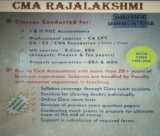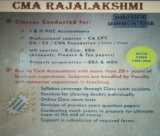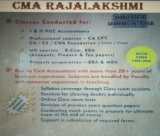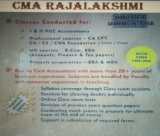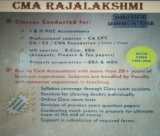BBA Semester I:
Run by Cost Accountant with more than 20+ years of business experience. Subjects are handled by faculty with immense experience in teaching.
Regular and weekend batches. Paperwise coaching is available.
Limited to 10 students per batch.
Courses would contain:
- Syllabus coverage through Class room sessions
- Sessions for clearing doubts individually
- Online Class room tests
- Revision of previous years Question papers
- Conducting mock exams to prepare for ultimate exam at the end of course
- Support in submission of required forms to Institute.
Papers covered:
INTRODUCTION TO FINANCIAL ACCOUNTING: Introduction â?? Meaning and Definition â?? Objectives of Accounting â?? Functions of Accounting â?? Users of
Accounting Information â?? Limitations of Accounting â?? Accounting Principles â?? Accounting Concepts and Accounting Conventions. Accounting Standards â??List of Indian Accounting Standards.
ACCOUNTING PROCESS: Meaning â?? Process of Accounting â?? Kinds of Accounts â?? Rules - Transaction Analysis â?? Journal â?? Ledger â??Balancing of Accounts â?? Trial Balance â?? Problems.
SUBSIDIARY BOOKS: Meaning â?? Significance â?? Types of Subsidiary Books â?? Purchases Book â?? Sales Book â?? Purchase Returns Book â?? Sales Return Book â?? Bills Receivable Book â?? Bills Payable Book â?? Cash Book (Simple Cash Book, Double Column Cash Book, Three Column Cash Book and Petty Cash Book) and Journal proper. Bank Reconciliation Statement â?? Preparation of Bank Reconciliation Statement.
FINAL ACCOUNTS OF PROPRIETARY CONCERN: Preparation of Profit& Loss Account and Balance Sheet(Vertical form).
SINGLE ENTRY SYSTEM: Meaning â?? Features â?? Types â?? Merits â?? Demerits â?? Differences between single entry and double entry systems â?? Preparation of Opening Statement of Affairs, Closing Statement of Affairs, Computation of Profit/Loss and Revised Statement of Affairs. Conversion of single entry to double entry system.
Quantitative Methods for Business â?? I:
NUMBER SYSTEM: Introduction â?? Natural Numbers - Even Numbers â?? Odd Numbers â?? Integers â?? Prime Numbers â?? Rational & Irrational numbers, Real Numbers, HCF & LCM ( Simple problems )
THEORY OF EQUATIONS: Introduction â?? Meaning â?? Types of Equations â?? Simple, Linear and Simultaneous Equations (only two variables) Eliminations and Substitution Method only. Quadratic Equation â?? Factorization and Formula Method (ax² + bx + c = 0 form only).
PROGRESSIONS: Introduction â?? Arithmetic Progression - Finding the â??nth term of an AP and Sum to nth term of AP. Insertion of Arithmetic Means in given terms of AP and representation of 3 terms of AP. Geometric Progression â?? Finding nth term of GP â?? Sum to nth Term of GP â?? Insertion of Geometric Means in given Geometric Progression and also representation of 3 terms of GP.
MATRICES AND DETERMINANTS:
Introduction, Meaning, types of matrices â?? operations of addition, subtraction, multiplication of two
matrices â?? problems, transpose of a square matrix. Determinant of a square matrix- minor of an element, co-factor of an element of a determinant. Adjoint of a square matrix, singular and non-singular matrices â?? inverse of a square matrix â?? Problems on linear equations in two variables using Cramer's rule.
COMMERCIAL ARITHMETIC: Simple interest, Compound interest including half yearly and quarterly calculations, annuities Percentages, bills discounting, concepts of Ratios, duplicate-triplicate and sub-duplicate of a ratio. Proportions, third, fourth and inverse proportion.



